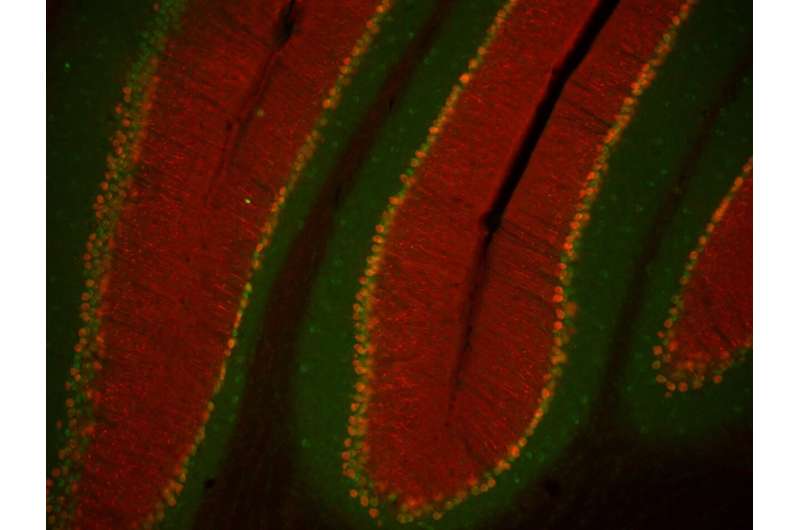
The cerebellum, a region at the back of the brain under the cerebral cortex, has been found to support movement and muscle control, as well as memory, learning and other mental functions. Some neuroscience studies have hypothesized that the cerebellum refines the movements of humans and other mammals via associative learning, yet this has yet to be established with certainty.
Researchers at the University of Colorado School of Medicine recently carried out a study exploring this possibility by changing the activity of the mouse cerebellum and observing how this impacted overall neural activity and the mice’s reaching behavior. Their findings, published in Nature Neuroscience, offer new valuable insight about the involvement of the cerebellum in motor control.
“The cerebellum is prized by those of us who study it as a tractable circuit—it is set apart from the rest of the brain yet linked to the rest of the brain through isolated input-output pathways,” Abigail Person, one of the researchers who carried out the study, told Medical Xpress.
“This structural feature makes it tempting to identify the ‘transformation’ of information as it passes through the input, middle and output layers of the cerebellum, essentially identifying a computation. Studies on behaviors such as delay eyelid conditioning take advantage of this feature and have identified ways in which the cerebellar circuit links events in the environment through associative learning.”
Well-established theories and past experimental evidence repeatedly showed that animals can learn to associate neutral sensory cues (i.e., conditioned stimuli), such as a sound or blinking light, with a painful or pleasurable experience (i.e., unconditioned stimuli). This is known as associative learning.
The key objective of the recent work by Person and her colleagues was to explore the possibility that associative learning in the cerebellum might underlie the learning and coordination of some body movements, particularly reaching behavior. They did this by conducting experiments on mice, who can reach their paws forward to grab food or touch other things in their surroundings.
“One of the hallmarks of motor coordination (which requires the cerebellum) is that early parts of movements are organized with later parts of movement—that is, they are not jerky and temporally disorganized,” Person said. “Also, those relationships can change if movements are poorly calibrated. If that’s true, then maybe one of the ways the cerebellum leads to coordination is by linking early parts of movements communicated by the isolated inputs to the cerebellum to motor control in late parts of the movement controlled by the isolated output of the cerebellum.”
A recent work by Adam Hantman’s lab at the University of North Carolina at Chapel Hill found that reaching behavior in mice could be disrupted by modifying input activity to the cerebellum. The study by Person and her team was inspired by this observation, along with theoretical predictions of how the cerebellum learns and coordinates movements.
“We reasoned that if we modified these inputs to the cerebellum on every reach, so that it became a ‘predictable’ perturbation, then the system might be able to learn and use that information to recalibrate and produce coordinated movements,” Person explained. “To test this hypothesis, we introduced a light-activated ion channel, channelrhodopsin, to an input pathway to the cerebellum. This allowed us to change its activity when we shined light on it which was facilitated with an implanted optical fiber.”
The researchers then triggered light pulses for short periods of time as the mice reached their paws, using a system that they carefully designed, where light pulses are essentially triggered by reach behavior. Every time the mice reached with their paws, this system input new information to their cerebellum via its dedicated neural pathway.
“As previously observed, we found that reaches were initially disrupted by stimulation of inputs,” Person said. “However, by disrupting activity on every single reach, we found that soon, reaches became normal, even though we were stimulating on those reaches. Then, when we stopped stimulating, reaches were disrupted again, even though we were not stimulating. This means that the cerebellum learned to use the new information that we provided with the optogenetic stimulation became a part of the motor plan.”
Overall, the findings gathered by this team of researchers suggest that associative learning in the cerebellum influences the learning and coordination of reaching behavior in mice, and thus potentially also in other mammals, including humans. In the future, new studies could try to verify this hypothesis in other animals or looking at alternative movements or motor behavior.
“Our study linked basic associative learning like delay eyelid conditioning with principles of skilled motor control and learning,” Person added. “In our next works, we plan to investigate the mystery related to the teaching signal—how it detects what is wrong and how its signaling leads to rapid changes.”
More information:
Dylan J. Calame et al, Cerebellar associative learning underlies skilled reach adaptation, Nature Neuroscience (2023). DOI: 10.1038/s41593-023-01347-y
Journal information:
Nature Neuroscience
Source: Read Full Article